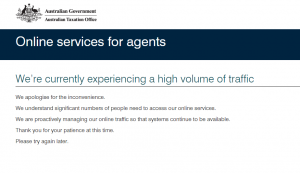Posts Categorized: COVID-19 strategies
21 tips about the new & improved instant asset write-off – part 1

In all my years as a business and tax advisor to small and medium businesses, there has never been a tax incentive that attracts as much interest as the instant asset write-off.
And now it has become even more attractive!
And what was to be until December a $150,000 limit for small businesses has now become a complete write of all equipment purchases for any business with turnover under $5 billion.
In such difficult times as this, it can deliver even greater outcomes when combined with the carry back of company losses.
But before doing so, please ensure you have factored in the following 20 key considerations:-
-
This concession originally only applied to the purchase of new assets. However businesses with group turnover under $50 million can now deduct the cost of second hand assets.
-
It does not apply to building or capital works nor software development pools or primary production assets.
-
If your business sells expensive assets, this expanded concession should prove to be a major buying incentive for your customers; even more so if you offer funding solutions. Ask us if you would like a worked example to use with your customers
-
Only buy an asset if you need it. So, if a company registered for GST buys and asset for $11,000, it will get back $1,000 of GST and will have a tax deduction of $10,000. It will pay $2,600 less company income tax. It will still be $7,400 out of pocket. As tempting as this limit is, don’t get too carried away and buy assets that your cash flow cannot support.
-
A tax deduction in the 2020/21 tax year will have a flow on effect as it will reduce the PAYG Instalments for 2021/22 and part way into 2022/23.
-
An asset purchased in 2020/21 will also have a flow on effect for those small businesses paying GST under the instalment method. It will reduce the GST Instalments for 2021/22 and part way into 2022/23.
-
Writing of large assets may be great for tax but can make your financials look ordinary, possibly disastrous to a current or future financier. For this reason, we now run two sets of depreciation schedules; one for tax and one for accounting / financial statements purposes. Effectively the tax rates are a nonsense and they should not make your financials misleading.
Please come back to this web page for a further 14 tips and traps.
We welcome any question you may have in the meantime.
Extension of commercial rent relief scheme

It is important to understand the background to the rent relief scheme. And as it is linked to JobKeeper, let us start there.
We have now entered what is best termed as JobKeeper Version 2.1. Those that qualify based off the September quarter will receive payments through the December quarter.
As of Monday, this means that we now have four types of employers:-
-
Those that qualified to continue to receive JobKeeper.
-
Those that have now qualified to receive for JobKeeper for the first time.
-
Those that have fallen out of the JobKeeper system and may not return for the March quarter.
-
Those that have fallen out of the JobKeeper system and but may return for the March quarter.
Receiving JobKeeper has been critical to enabling employers to keep their employees engaged, productive and not otherwise on social security.
Having qualified for JobKeeper has also been critical to business survival as with it comes the ability to claim some state grants and qualify for commercial tenancy relief.
In itself, the rent relief scheme has been the biggest saviour of small businesses. The scheme allows for rents to be reduced proportional to the fall in turnover. At least half of the rent reduction must be waived, the balance is payable either over the longer of the duration of the lease or 24 months.
This scheme was due to expire on 28th September when JobKeeper was supposed to end. However, legislation was finally passed this week by the state government which has extended this rent relief system to 31st December.
So businesses that qualify for JobKeeper through to the end of the December quarter can now re-apply for extended rent relief.
To do so, a business must provide to the landlord:-
-
A statement confirming turnover is under $50million.
-
A statement that the lease is eligible to be covered by the scheme.
-
JobKeeper registration number.
-
A statement stating decline in turnover support by one of:-
– accounting record extracts or
– BAS’s for the relevant periods (which means that those who lodge an Annual GST Return can’t use this method) or
– Bank statements or
– A letter from your accountant (for which we have supplied a number).
TIP Make your application as soon possible as the relief only applies from application date.
Practically speaking, an application can’t fail. It is true that a landlord can refuse an application. But should they refuse the matter can then be referred to mediation. And if they refuse to enter mediation, then the matter can be referred to VCAT. Either way the landlord is bound to lose as there will be a hearing and they are acting outside the mandatory code.
It is beyond the scope of this blog to explore every nuance and possible scenario. We do though welcome any query you may have.
Alternative ways to qualify for JobKeeper

Did you miss out on qualifying for JobKeeper?
Maybe you don’t.
The 30% fall in turnover test where a small business compares its turnover for July, August and the September last year to this year is not the only test. And yes, that test can yield some unexpected and unfair results as for most small businesses it measures what was banked during those two periods.
There are many circumstances where that test is an improper measure. In recognition of this, the ATO have released 7 alternative tests and include tests for:-
-
A businesses started in the last year.
-
Where there has been a substantial rise in turnover (which is often the case in a business progressing through its second or third year).
-
Businesses with irregular turnover.
-
Sole traders or small partnerships where there has been injury, illness or leave taken.
Maybe one of these four tests or the other three will see you qualify for another 7 fortnightly JobKeeper payments.
And if you do, you may then qualify for another $10,000 state grant.
And you will also qualify for extended commercial rent relief to the end of December.
Just as we achieved at the start of JobKeeper, working through these tests has resulted in clients qualifying for JobKeeper who failed the basic test.
So perhaps you do qualify for the extended JobKeeper period. As we are passionate about helping small businesses survive (and which are after all the engine room of the economy) we welcome the opportunity to explore your situation.
10 key actions to claim JobKeeper v2.1

JobKeeper as we know finishes on Sunday 27th Sep.
It is not automatic that current recipients will continue to receive this valuable government support. On the other hand, employers who did not qualify previously may now do so.
You now have just 9 days to be able to claim from Monday 28th September.
To claim for JobKeeper v2.1, you will need to have 10 key actions completed (and pronto):-
-
Have your accounting file up to date with correct GST allocations
-
Assess your decline turnover under the new definition of GST turnover
-
If you fail re-assess under newly set alternative tests
-
Work out which employees will qualify
-
Work out which of the two new rates apply to each employee
-
Issue and collect completed newly qualified employees with a JobKeeper Payment Employee Notification form
-
Advise employees what their rate will be
-
Register new employees
-
Attend to same process for eligible business participants
-
Update payroll system
If you want to know more, you can enrol in our free webinar which will be held at 5.30pm on Monday 28th September – to do so click here
We welcome any question you may have – please e-mail accountants@mrsaccountants.com.au
JobKeeper – ATO’s final opinion on measuring turnover
As we all may now know, a small business can access JobKeeper reimbursements from when turnover fall by 30%. Treasury surprisingly proposed that turnover be defined as being GST turnover.
That’s when the confusion started!
All the big accounting firms and research houses were adamant from the start that a small business could assess a fall in turnover on either an accrual basis (when an invoice is raised) or cash basis (when money is received) where a small business reports GST on a cash basis.
The ATO appeared to agree with this. Then they reversed their position by saying that turnover had to be assessed on the basis of the GST registration. This meant cash for the majority of small businesses.
A cynic would say this was done to reduce the number of firms that could receive JobKeeper.
How would that be?
Well cash is a lagging indicator. A very convenient way to ignore reality – reality being that the true measure of a downturn and when it happens is when the value of invoices raised fall.
Thankfully reality has been recognised. Last Monday the ATO officially stated that a small business that reports income on an accruals basis (as in the accounting software and Tax Return reports income when an invoice is raised) could identify a fall of more than 30% in turnover on either a cash or accrual basis. Yes, you get to pick the best result.
We have since re-visited our clients’ positions.
Please contact us if you would like help assessing whether your turnover has fallen enough for you to know qualify. We have read the ATO’s companion paper and are across all other considerations. We welcome your call.
JobKeeper money flowing!
Today we have the distraction of ATO systems crashing and not being able to complete the JobKeeper enrolment process. That said, we are however pleased to report that some of our clients have today received the JobKeeper payments for the first two fortnights.
Being a reimbursement process, many businesses will be using that to fund the balance of the JobKeeper fortnight ending Sunday, particularly those that have casuals earning less than $1,500pf.
And whilst on the matter of Sunday, please ensure you have topped up employees’ pays where their gross is under $1,500. Our clients will know this given the educational program we have delivered. If we are not your accountant, then we suggest it is time you were.
ATO crash!
Tax agents around the country currently can’t log into the Tax Agent Portal to attend to the next stage of JobKeeper reporting.

Once again ATO systems fail to handle the workload they created! Blind Freddie should have seen and PREPARED for all agents to pretty much be logged on at once. And who suffers – all those business owners waiting for the monetary lifeline!
It appears the ATO hasn’t appreciated in any way the rules, systems and requirements that they have put in place.
Take for example the enrolment process. Again even Blind Freddie could have foreseen that:-
-
Many would presume that registering their interest was actually enrolment.
-
Seven, yes only 7 days from Monday 20th to Sunday 26th April was never going to be enough time for everyone to enrol. And even then it took them 5 days to work out the process needed to be extended to 5 weeks.
It reminds me of the ATO’s 5 in 5 service when GST was introduced. They promised to reply to any question within 5 days. 5 weeks was quickly the norm; then followed in time by being lucky if ever got an response.
As it is their JobKeeper support is poor – to say the least. We have ATO staff simply hang up or refer us to a link (that didn’t answer the question) and then promptly hang up.
So we will just keep trying to log in and stay back as long as is necessary.
Why didn’t they just adopt the UK system which sounded much simpler and appears to have fewer anomalies?
JobKeeper payment bridging finance
There are a number of oddities about the JobKeeper system. Whilst designed to support businesses in stress retain their employees, it is a reimbursement system – it requires the employer to pay the employee first and then receive a reimbursement in the following month.
It particularly tough on those with a casual workforce where the average pay is under $1,500 per month. For a casual earning say $600pf, an employer must top it by $900 to $1,500 in order to qualify for a reimbursement. That is a very significant cash hit for a business that is already stressed! No wonder why so many businesses who registered interest haven’t enrolled into the system.
Following a fair amount of political pressure, the four major banks have been requested to provide bridging finance. They will not be giving money away; they will be assessing applications with a short term focus and presumably with some level of security.
As a side point, I have yet to hear of any business yet take out one of the government backed loans.
The four major banks (as well as the next tier of Westpac subsidiaries ) have set up dedicated JobKeeper support hotlines.
They can be contacted on the following numbers:-
-
CBA: 13 26 07
-
ANZ: 1800 571 123
-
NAB: 1800 JOBKEEPER
-
Westpac: 1300 731 073 and Westpac’s subsidiaries;
– St George: 1300 730 196
– Bank of Melbourne: 1300 784 873
– Bank SA: 1300 669 472
They will of course not consider a bridging application without:-
-
Confirmation of JobKeeper entitlement, and
-
At a minimum a detailed cash flow projection, but also expect to be asked for forecast Profit & Loss and Balance Sheet. That said, a business receiving JobKeeper will have to provide the ATO with projected turnover by the 7th day of every month.
Upcoming key JobKeeper dates
Well, we have got through the enrolment process. What a wild ride that was! Whilst many fundamental questions remain unresolved, at least we have more clarity than we had last week.
So we just wanted to update you on upcoming key JobKeeper dates.
Before doing so, we remind you that enrolments only opened on Monday 20th April. And registration prior to that was only of interest in the scheme. If you have not enrolled since 20th April, then you will receive nothing until you do so.
We noted that only some 500,000 out of the 800,000+ businesses that registered their interest in applying for JobKeeper had since enrolled as of last night. In other words, one in every businesses has not enrolled.
Why such a disparity? We reckon there would be four reasons:-
-
Some don’t realise they still need to enrol.
-
Many have found out that one way or the other, they are precluded from qualifying.
-
They don’t qualify yet.
-
They have a casual workforce and have chosen not to enrol and find they don’t qualify but have topped up casuals’ pays to $1,500 for which they don’t get reimbursed.
So what are the upcoming key JobKeeper dates?
4th May – identify all eligible employees AND notified all eligible employees and update them on process.
8th May – topped up eligible employees to $1,500pf (has been extended).
31st May – enrol to be able to claim for April JobKeeper fortnights (has been extended form last Sunday).
We welcome any question you may have.
JobKeeper tasks
So past, current and future JobKeeper tasks can be summarised as follows:-
-
Determined your turnover in accordance with the modified GST turnover definition.
-
Assessed yourself against any 9 of the testing periods (or 18 depending on accounting and GST recognition methods).
-
Assessed against alternative tests when a new business or abnormal period(s).
-
If you don’t qualify now based off months, monitor when you may apply.
-
Prepared a full and proper forecast where claiming for June quarter.
-
Determined eligible employees.
-
Determined eligible business participant.
-
Enrolled for JobKeeper.
-
Pay each eligible employee $1,500 within each JobKeeper fortnight. There is an extension to 30th April for the two fortnights ending 27th April.
-
Notify each employee that they will receive JobKeeper.
-
Amend your payroll system.
-
Consider changing your payroll periods.
-
Continue to report required information to the ATO.
If I can leave you three thoughts they would be:-
-
Don’t proceed unless you are 100% certain as to what you are doing, AND
-
This has been formulated and introduced in a hurry so be up to date with all the changes and clarifications, AND
-
To quote Donald Rumsfeld, be very mindful that there may be unknown unknowns.
